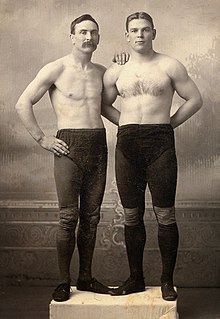Frank Gotch
[2] The son of Frederick Rudolph and Amelia Gotch, of German ancestry, he was born and raised on a small farm three miles south of Humboldt, Iowa.
Only later when he received the impressed man's visiting card, did he learn that his opponent had actually been reigning American Heavyweight Champion Dan McLeod.
After trading the title with Jenkins and Fred Beell, Gotch set his sights on the World Heavyweight Wrestling Championship, then held by the undefeated Estonian George Hackenschmidt.
Gotch tore him off the ropes, threw Hackenschmidt down and rode him hard for three minutes, working for his dreaded toe hold.
The wrestlers then retired to their dressing rooms before coming out for the second fall, but Hackenschmidt refused to return to the ring, telling the referee to declare Gotch the winner, thereby relinquishing his title to him.
He was invited to the White House by United States President Theodore Roosevelt, and wrestled a Japanese ju-jitsu expert in the East Hall, making his opponent submit.
The night before his second match with Hackenschmidt, he attended a Chicago Cubs baseball game at Wrigley Field with his wife and in-laws and took his seat down front.
Gotch met Hackenschmidt again on September 4, 1911, at the newly opened Comiskey Park in Chicago, which drew a crowd of nearly 30,000 spectators and a record gate of $87,000.
The rematch is one of the most controversial and talked about matches in professional wrestling history, as Hackenschmidt injured his knee against Roller, his chief training partner.
Years later, wrestler Ad Santel told Lou Thesz that he was paid $5,000 by Gotch's backers to cripple Hackenschmidt in training, and make it look like an accident.
[15] Gotch reigned as the World Heavyweight Wrestling Champion from his first victory over Hackenschmidt in 1908 until he retired in 1913 after defeating Estonian Georg Lurich April 1, 1913, in Kansas City, Missouri.
Critics saw in him both the strength of the old school of professional wrestling and the skill of the new, "as agile as a cat in his manoeuvers" and having "the grappling sport down to such science that he had assumed a rank all by himself".
[18] Gotch's measurements for his 1911 victory over Hackenschmidt were: age – 33; weight – 204 pounds; height – 5'11"; reach – 73"; biceps – 17.5"; forearm – 14"; neck – 18"; chest – 45"; waist – 34"; thigh – 22"; calf – 18".
[19] There is another side to this story that, when Lou Thesz was just starting out in the early 1930s, there were a good many professional wrestlers still active who had known Gotch and were not reluctant to talk about him.
"The picture that emerged of Gotch from those conversations", Thesz recalled, "was of a man who succeeded at his business primarily because he was, for lack of a kinder description, a dirty wrestler.
But those same people described him as someone who delighted in hurting or torturing lesser opponents, even when they were supposed to be working out, and he was always looking for an illegal edge when he was matched against worthy ones.
[20] Referee Ed Smith, who officiated several of Gotch's bouts, including both of the Gotch-Hackenschmidt contests, had observed after the second match that "to my mind... he wasn't just exactly through one hundred percent on the courageous side.
Always will I think that the really courageous man, no matter how ferocious and filled with the killing instinct and eager to win he may be, is willing to let up on a beaten foe and not punish needlessly or wantonly".
After a year of health troubles, Gotch died at home in 1917 of what was rumored to be syphilis, but the official cause of death was uremic poisoning.
[23] As Mark Palmer pointed out, "For starters, George Hackenschmidt and Frank Gotch were major sports superstars of the early 20th century.
Their epic matches were front-page news around the world—akin to today's Super Bowl or soccer's World Cup in terms of garnering global attention—and helped to launch organized amateur wrestling in the United States in the early part of the 20th century.
[24] Gotch was also a major sports superstar, often called the Hulk Hogan of his day, who lifted professional wrestling to new heights of popularity.
Horse racing remained a favorite sport and major league baseball was growing in popularity, but was not yet the national pastime.
Automobile racing was in its infancy; golf was still the province of the wealthy; basketball had just been invented and was vying for attention; boxing offered a man a chance at fame and fortune, but was at this time riddled with scandals; the National Hockey League was formed the same year; and college football—the Ivy League game—was on the verge of being outlawed because it was too rough and too dangerous.
In India, The Great Gama was already a legendary champion, and in Europe, George Hackenschmidt had reigned supreme with Stanislaus Zbyszko coming along.
[38] On display are the wrestling shoes he wore into the ring in 1911 against Hackenschmidt, his Mason's sword and leather scabbard, the roll-top desk that sat in his living room in Humboldt, and many other rare items.
Roy Wood, head coach at The Snake Pit in England, was an honored guest at the event and led a catch wrestling seminar on July 2.
weight disadvantage to Travis Wiuff in the final, who he beat with a Gotch toe hold, and Anthony Pachek placed third.

